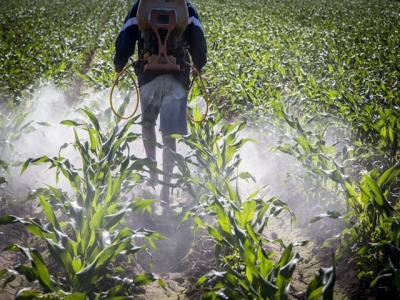Use your herbicides more effectively

If you want lands free of weeds, herbicides must be used properly. The first principle is timing.
Applying the post-emergence herbicide Linuron was delayed on this crop of carrots and the quickweed could not then be eradicated. Photo: Bill Kerr
Weeds are more susceptible to herbicides when younger. This can be clearly seen in carrots, in particular. Quickweed (Galinsoga parviflora) is easily killed by Linuron when young, but as soon as it gets close to flowering, it is able to resist the product. So many farmers, thinking quickweed is easy to kill at any stage, delay the post-emergence application, usually as a result of procrastination, and then are surprised when the herbicide doesn’t seem to work.
Staying with carrots, certain grass weeds, such as goose-grass and sweetgrass, can also become a problem when there’s a delay in the post-emergence application of Linuron. Misinterpreting the label. In fact, a lot of weed problems are the result of the label on the chemical being misinterpreted. In the case of Linuron, it states that the herbicide should be applied to carrots at the 4-leaf stage.
I find most farmers take this to mean four ‘true leaves’, which is incorrect. Instead, by ‘4-leaf stage’, the label means two dicotyledon leaves and two true leaves. If it meant four true leaves, the label would say so! Furthermore, at the 1- to 2-true leaf stages, the weeds are still so small they’re much more susceptible to the herbicide. In fact, at the 2-true leaf stage, you’ll get far better weed control using less herbicide than will be needed at the 4-true leaves stage.
When I was farming, I was able to get better weed control at half the rate of herbicide than other farmers were using by coming in at a young stage. With carrots you can also get better overall weed control by using two different products, each of which is effective against different weed species. Stomp has been widely used for many years as a pre-emergence herbicide. It’s applied at a low rate just before the first irrigation after planting. In combination with Linuron – used at the post-emergence stage – it gives super results. Stomp is not registered in the country for this crop due to the cost of registration for its limited use, but is registered in many countries.
Overtaking the crop
Sometimes a product label dictates that the crop has to be a certain stage of development before the chemical can be applied. I’ve often come across this with onion farmers, who find weeds are overtaking the crop which still has to reach the size when the label declares it’s safe to use a product. This is invariably the 3-leaf to 4-leaf stage. I find that it’s better
to apply the chemical at a reduced rate to suppress the weeds so that the onions can reach the stage where a full application can be given.
If you don’t do this, the crop will be severely damaged. Even if the crop suffers slight scorch, the weeds will suffer much more damage. It’s useful to glean as much information as possible on the herbicides you use. As most farmers have internet access, it’s really worthwhile looking up the technical bulletins for more information than can be found on the label. The label has to provide a lot of information about safety hazards, medical issues and so on, which is required to protect the company.
Much more relevant information relating to water quality, pH and other subjects can be found in these technical bulletins. If farmers read these, they would not be confused about the 4-leaf stage of carrots!
Related news
 Green asparagus offers high profits for Ninh Thuan farmers
Green asparagus offers high profits for Ninh Thuan farmers Farmers in the south central province of Ninh Thuan are growing more green asparagus as the vegetable is offering higher profits compared to other crops
 Vietnam aims to facilitate agriculture investment
Vietnam aims to facilitate agriculture investment In a bid to revitalise the agricultural sector, Vietnam aims to introduce more effective policies with the goal of spurring agricultural development
 Luc Nam custard apple enjoys high price
Luc Nam custard apple enjoys high price It is the harvest season of custard apple in several localities in Luc Nam district, Bac Giang province. Though the cultivation area increases